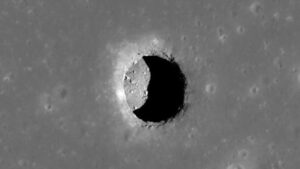6EQUJ5. It looks like a random sequence of numbers and letters, but it is anything but random. On August 15, 1977, the Big Ear radio telescope at Ohio State University picked up this sequence. It was a powerful radio signal from deep space whose origin remains unknown to this day. The best-known theory: It comes from an intelligent extraterrestrial source.
Background
Radio telescopes first detected radio waves from space in the 1930s. After World War II, major advances in using radio technology for space exploration provided a whole new way of looking at the night sky. These signals could also reveal celestial happenings invisible to the naked eye.
Radio signals come from space every day. They originate from planets, galaxies, nebulae, stars, black holes, supernovas, quasars, magnetars, and even comets. Telescopes process and map the signals, revealing to us celestial objects and phenomena we never knew about.

Radio telescopes. Photo: Ben Wicks/Unsplash
One well-known radio telescope was Big Ear, the nickname for the Ohio State University Radio Observatory. A real labor of love, it was completed in 1961 by inventor John Kraus, along with volunteers and university students. It consisted of a 152m by 109m aluminum flat area with two reflectors at each end. One reflector was curved while the other was flat but could tilt up or down. In the middle of the aluminum field lay two funnel-shaped “feed horns.”
The telescope was stationary and depended on the earth’s rotation to search for signals. The radio signals would strike the flat reflector, travel across the aluminum field toward the curved reflector, bounce off it, and go into the feed horns for scientists to process.
Wow!
From 1965 to the 1970s, the observatory worked on the SETI (Search for Extraterrestrial Intelligence) project, among others. It was more of a volunteer effort from radio astronomers with a passion for the subject. They sought to program the telescope to look for specific signs of extraterrestrial life. The frequency band they used was 1420.40575177MHz, also known as the Hydrogen Line or 21 Centimeter Line.

A radio telescope in New Mexico. Photo: Donald Gianatti/Unsplash
Physicists Philip Morrison and Giuseppe Cocconi first suggested this theory in the late 1950s. This frequency measures fluctuations in the energy of hydrogen atoms. The idea was that extraterrestrial intelligence might communicate on this frequency since it was quite powerful and hydrogen makes up most of the universe.
The telescope captured such fluctuations, and an old IBM 1130 computer processed and printed them. These printouts consisted of 50 columns (representing 50 channels) of alphanumeric figures. The numbers and letters measured a signal’s intensity. Low intensities were below 10. Ten and above turned into letters of the alphabet.
Radio astronomer Jerry Ehman was the person responsible for collecting and analyzing this data from Big Ear. He received printouts a couple of times a week, which he examined for unusual activity.
One night when no one was listening, at 11:16 pm on August 15, 1977, the telescope received a startling radio signal. Ehman only saw the data afterward. When he poured over the pages, he found a very intense signal that the computer printed as “6EQUJ5.” It lasted for 72 seconds, increased for 36 seconds, then decreased for another 36 seconds, as the telescope moved away from the signal’s point of origin as the Earth rotated.
Ehman circled that sequence with a red pen and wrote ‘Wow!’ next to it, thus giving it its iconic name. After further analysis, they found that the telescope was pointing toward somewhere in the constellation of Sagittarius.
Theories
The SETI team was completely stumped. They kept careful watch, but there have been no repeats of the signal since. Subsequent studies with other radio telescopes found nothing, either. Eventually, the scientific community shunted the mystery aside.
But some remained convinced that this was the breakthrough they had been waiting for. One writer archly cited the old line that “absence of evidence is not evidence of absence” where SETI projects are concerned.
At first, the main theory was that the signal came from a natural source. Spanish scientist Alberto Caballero found a star much like our sun near the Wow! signal’s location at that time, dryly called 2MASS 19281982-2640123. It is 1,800 light-years away from us. However, subsequent observations found that it emitted no such signal. Other possible natural sources included exoplanets and comets.

Stars in the constellation of Sagittarius. Photo: NASA
Comets?
In 2017, astronomer Antonio Paris suggested that comets might be the cause. He pointed out that two comets, 266 P/Christensen and 335P/Gibbs, were traveling within a hydrogen cloud at that time and generated the signal.
While promising at first because of the hydrogen cloud, Seth Shostak from the SETI Institute stated, “The comet hypothesis, in my opinion, doesn’t work…I’ve never heard of anyone measuring strong hydrogen signals from a comet…but comets on the other side of the Solar System, as these were, don’t move fast enough to appear in the Big Ear’s beam, then disappear scarcely a minute later.”
Was it simply interference from Earth? A telescope malfunction? There were hundreds of satellites in Earth’s orbit at the time. However, it is unlikely that something on Earth caused it.
Perhaps the signal is an FRB (fast radio burst). These intense radio signals only appear once and are very common in the night sky. Yet this does not explain why this type of signal did not pop up again.
Conclusion
The astronomy community has basically abandoned the search for the Wow! Only one person, data analyst Robert Gray, persisted. He set up a telescope in his backyard and eventually accessed stronger telescopes at Harvard University. However, nothing turned up.
Because of the limitations of the telescopes of that era, it is hard to say exactly what it could have been. If it was extraterrestrial intelligence that wanted to communicate with us, why hasn’t it happened again? Are they so far away that we will have to wait decades for another transmission? Or did we simply miss a very powerful cosmic event?
The probability of intelligent life beyond Earth is high, according to some. For now, we are stuck with a singular event that could be the answer to one of humanity’s most important questions, but which lies on the shelf as a dead-end curiosity.






